

OUbl62B.png (606×726) Neurological Examination of the Lower Limbs. oPatientPlus articles are written by UK doctors and are based on research evidence, UK and European Guidelines.
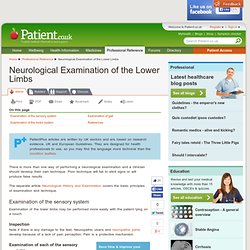
They are designed for health professionals to use, so you may find the language more technical than the condition leaflets. There is more than one way of performing a neurological examination and a clinician should develop their own technique. Poor technique will fail to elicit signs or will produce false results. The separate article Neurological History and Examination covers the basic principles of examination and technique. Examination of the lower limbs may be performed more easily with the patient lying on a couch. Inspection Note if there is any damage to the feet. Examination of each of the sensory modalities Light touch: Sharp touch (pinprick): Test using a dedicated disposable pin. Temperature: Joint position sense (proprioception): Vibration sense: 2-point discrimination: Interpreting the findings[1] Tone Power Deep tendon reflexes. BONDAGE BASICS *English*
Shibari, Kinbaku, Japanese bondage from Amsterdam, the Netherlands - Articles. Let's discuss the femoral cutaneous nerve and the problems that can come from this related to kinbaku.

Here's the situation Consider a face down suspension where the pelvis and the upper legs are supported (next to all other support points). Here's an example shot to give you an idea what sort of support points I'm talking about Your session goes without problems your model experiences no problems, or "bad pain" at all. Some time AFTER the session, when your model is resting or you are talking over the session, the front center of one of the upper legs starts to feel numb. The front center of the upper leg is approximatly a 4"x8" area, and specifically this area, or part of this area starts to feel numb.
What is happening here? Back in the Victorian Era and there was a "Corset disease". Based on the numbness and the area described (front center of the upper leg) it is most likely a compression of the Femoral nerve. How was this caused? How can this be avoided? Conclusion Bob September 2005. Bondage safety by Esinem: Part 1 of 2. Www.petrospec-technologies.com/Herkommer/knots/FM5-125.pdf. Carabiners, Part 3 - Properties. The point of this mini-series on carabiners is to understand how different aspects and qualities of a carabiner affect its usefulness in technical rescue rigging.
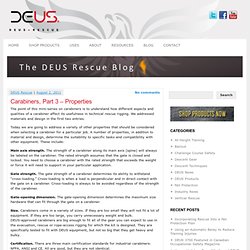
We addressed materials and design in the first two entries. Www.stagesafe.co.uk/user_files/Suspension-trauma.pdf. Nerve and Circulation Problems. I think the two most common and often misunderstood problems in rope are circulation and nerve problems and more importantly how to spot the differences between them.
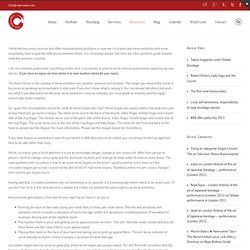
It is not always simple, but here are a few points to guide towards what the problem could be. I am not a medical professional, everything written here is my opinion or given to me by medical professionals regarding my own injuries. If you have an injury my best advice is to seek medical advice for your injury. The three factors in the causing of nerve problems are, position, pressure and duration. Rope Safety Web Resources. RigCalc. RigCalcby Delbert L.
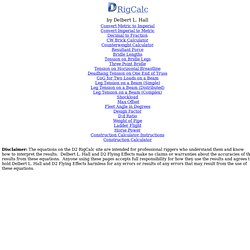
Hall Convert Metric to ImperialConvert Imperial to MetricDecimal to FractionCW Brick CalculatorCounterweight CalculatorResultant ForceBridle LengthsTension on Bridle LegsThree Point BridleTension on Horizontal BreastlineDeadhang Tension on One End of TrussCoG for Two Loads on a BeamLeg Tension on a Beam (Simple)Leg Tension on a Beam (Distributed)Leg Tension on a Beam (Complex)Shockload Max OffsetFleet Angle in DegreesDesign FactorD:d RatioWeight of PipeLadder FlightHorse PowerConstruction Calculator InstructionsConstruction Calculator Disclaimer: The equations on the D2 RigCalc site are intended for professional riggers who understand them and know how to interpret the results.
Delbert L. Hall and D2 Flying Effects make no claims or warranties about the accuracies of the results from these equations. Radial nerve rotation. Note 1: Maybe better word instead rotation should be "pronation", but I am not sure.

Pronation means turning back of forearm to front (supposed that hand is down beside body). I have seen a pronation movement on medical software, but this movement seemed to me unlikely, because only forearm turned, but the humerus bone of upper arm did not rotated. So in this article I suppose that humerus bone rotates when you try to give hand in takate kote position. Note 2: This article concerns only one vulnerable area, that is placed just under Deltoid muscle. Science, liability, use of force, and restraint asphyxia. Adversaries involved in civil lawsuits and criminal legal actions often call on scientific study to support their arguments — this practice has been part of the American legal system since the 1800s.
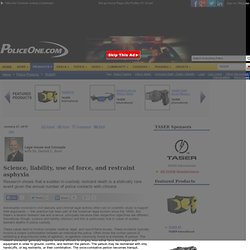
But there’s a tension between law and science, principally because their respective objectives are different. Sometimes though, science and liability intersect and this is particularly true in cases of sudden restraint deaths in police custody. These cases tend to involve complex medical, legal, and use-of-force issues. These incidents typically involve a violent confrontation between an individual the police. Often times the civilian person is exhibiting a drug-induced state of agitation, or agitation commonly found in a mentally ill person. Autopsy findings may fail to show anatomic or toxicological results sufficient to explain the death.
Both perspectives underscore the tension between science and the law that intersects from a sudden in custody death. Www.kinkfriendly.org/wp-content/uploads/2010/12/Risk-Chart.pdf. Pubs.army.mil/doctrine/DR_pubs/DR_a/pdf/fm4_25x11.pdf.